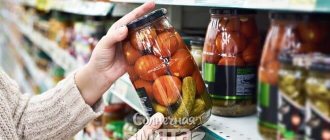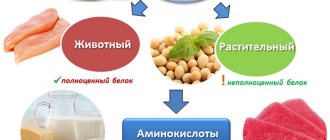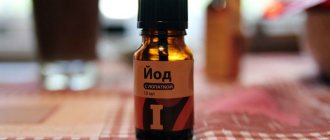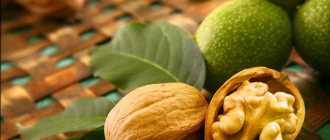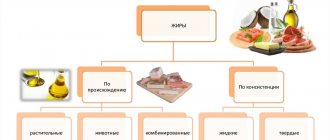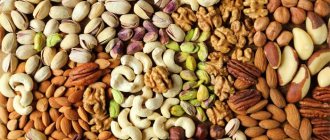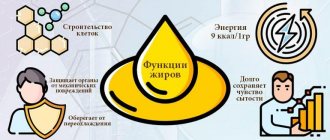Foods rich in selenium
It is somewhat incorrect to talk about foods that are rich in selenium, because food contains the mineral in tiny doses. However, selenium can be found in small dosages in many foods.
Selenium is present in sea and rock salt, as well as in seafood: squid, shrimp, fish, etc. It is also found in meat, offal, milk, and eggs.
Among plant products, it is most abundant in cereals, bran, corn, garlic, and mushrooms. It is also found in yeast.
How many do you need?
The daily requirement of an adult for selenium is approximately
50 mcg. Children under one year old need significantly less of this substance - about 20 mcg.
But, since selenium is toxic in large doses
, experts do not recommend consuming more than 400 mcg per day.
The upper limit for infants is 45 mcg per day. This mainly applies to those who receive selenium in the form of vitamin and mineral preparations or dietary supplements. Along with food, an overdose of selenium can only be obtained in those areas where the soil is oversaturated with it. Russia is one of the regions experiencing selenium deficiency.
Biological role of selenium
Selenium functions:
- It is one of the minerals with an antioxidant effect, “working” in the body together with vitamin E. They prevent the formation of free radicals in the body, which has a healing and rejuvenating effect
- Improves the production of thyroid hormones, and therefore promotes the manifestation of their effects: improved metabolism, weight loss, improved skin condition, rejuvenation, etc.
- Protects the heart and blood vessels, slows down the development of atherosclerosis
- Participates in the regulation of cell division and renewal
- Improves the condition of the pancreas
- Contains many enzymes and hormonal substances
- Participates in ensuring visual acuity
- Protects the body from heavy metal salts, helps it get rid of toxins
- Increases the effectiveness of vitamin C on the body
- Strengthens immunity
- Accelerates tissue recovery after damage to various diseases and injuries
- Has an anti-cancer effect!
General information
It is interesting that the mineral actively migrates in the biosphere; the accumulation of the compound in living organisms occurs due to inhalation of volcanic fumes, contact with calcareous rocks, thermal waters, and regular consumption of products grown in soil enriched with the microelement.
Selenium is actively dissolved in concentrated nitric acid and alkalis. In air, it is resistant to oxygen, water, sulfuric and hydrochloric acids.
In the human body, the mineral accumulates in the liver, kidneys, spleen, heart, bone marrow, lungs, skin and spermatic cords. The total concentration of the microelement in the internal organs does not exceed fourteen milligrams (match head). In microdoses it is found in the nuclei of all cells.
For better absorption of selenium, it is recommended to simultaneously take vitamins E,. At the same time, sulfates, mercury, phenacetin, copper, paracetamol, antimalarial drugs, on the contrary, reduce the absorption of the compound, which can ultimately lead to the development of mineral deficiency in the body.
Selenomethionine, selencysteine (the natural form of the compound) has the highest degree of digestibility - up to 98%. The body absorbs only 30% of the element from the animal form, and 10% from the inorganic form (sodium selenite).
Signs of selenium deficiency
If the selenium content in the body is insufficient, a person experiences weakness, muscle pain, a tendency to cardiovascular diseases, and the condition of the pancreas and thyroid gland worsens.
There is an increased incidence of illness due to weakened immunity. With a lack of selenium, the effectiveness of vitamin E entering the body decreases. This causes disruption of a number of physiological processes, accelerated aging, hormonal disorders, and infertility.
Selenium intake rate
The National Institutes of Health recommends that people over the age of 14 consume 55 micrograms (mcg) of selenium per day. For pregnant women or breastfeeding women, this figure should be increased to 70 mcg. Anything over 900 mcg per day is considered toxic.
Overdosing from natural sources is extremely rare, but overdosing on highly concentrated supplements can have negative effects. How is selenium harmful and what problems may arise?
- metallic taste in the mouth and unpleasant odor
- brittle nails
- stains on teeth or tooth decay
- gastrointestinal problems, as well as nausea
- neurological disorders
- fatigue and irritability
- rash
- hair loss
Selenium deficiency leads to impaired absorption of vitamin E by the body, and can also cause a number of symptoms and diseases. The most common ones are:
- infertility in men and women
- muscle weakness
- fatigue
- hair loss
- weakened immune system
The amount of selenium in foods is largely determined by the quality of the soil used to grow them. Precipitation, evaporation and pH levels affect selenium concentrations in the soil.
A 2021 study estimates that insufficient selenium intake affects up to 1 billion people worldwide.
Final thoughts on the benefits of selenium
- Selenium is a trace element found naturally in soil and certain foods. This mineral is also present in small quantities in water.
- Selenium benefits the body in a variety of ways. Some of the most significant benefits of selenium include protection against oxidative stress, heart disease and cancer; increasing immunity; regulation of thyroid function; increase in life expectancy; reduction of asthma symptoms; increasing the birth rate.
- Selenium helps the body largely due to its role as an antioxidant.
- The best food sources of selenium include Brazil nuts, eggs, sunflower seeds, liver, sea bass, tuna, herring, chicken breast, salmon, turkey, chia seeds and mushrooms.
Tags: Selenium
About the author: Larisa Kuts
Board-certified physician specializing in family medicine, geriatrics and integrative medicine. Clinical experience as a physician ranging from disease management to family practice and emergency care.
- Related Posts
- Polyunsaturated fatty acids: what foods they contain, benefits
- What is the difference between gelatin and collagen?
- 12 Health Benefits of DHA (Docosahexaenoic Acid)
« Previous entry
Acute selenium poisoning
Note!
Selenium is quite a toxic substance! Acute selenium intoxication is extremely rare and is observed when large doses of inorganic selenium are simultaneously ingested into the body, which is usually associated with accidental drug overdoses and man-made causes - accidents at selenium mining or processing facilities. In this case, clinical manifestations directly correlate with the amount of dose entering the body.
Symptoms usually include general toxic effects. The patient has:
- abdominal pain and frequent stools; This symptom gradually fades away over several days;
- constant nausea, vomiting, which does not bring relief, but is not profuse;
- a rather sharp, pronounced garlic odor from the mouth;
- severe headache, especially when moving, muscle pain;
- Occasionally, photophobia and lacrimation may occur in bright indoor lighting;
- weakness, increased fatigue, drowsiness without proper sleep.
Carrying out general detoxification measures in intensive care units is quite enough to help the body recover from acute selenium poisoning without any special consequences.
Important! There is no specific antidote for acute selenium poisoning.
Essential toxin
In the human body, selenium interacts with vitamins, enzymes and biological membranes, participates in the regulation of metabolism and is a component of more than 30 vital compounds, is included in the active centers of many enzymes and has antioxidant properties. The required daily dose of selenium for humans is 50–100 micrograms per day. However, if this dose is exceeded by just a few times, serious poisoning can occur. How to maintain selenium balance in the body with such a narrow range between harmless and toxic concentrations? And why is it so important for human well-being? These and other questions N + 1
answered Anatoly Skalny, professor, head and founder of the Department of Medical Elementology of RUDN University.
N+1
: What is selenium responsible for in the human body? How important is this element?
Anatoly Skalny:
For a long time, selenium was considered an extremely toxic element. Only in the second half of the 20th century were its functions discovered, which, on the contrary, were associated with detoxification and activation of the body’s antioxidant systems; functions that suppress inflammation and prevent the formation of various neoplasms.
Selenium has a great influence on the nutrition, development and functioning of muscle and connective tissue. It is very important to remember that selenium is one of the key elements that affects the body's absorption of iodine. It affects the enzyme deiodinase 2, which promotes the activation of thyroid hormones in tissues.
For humans, selenium is an essential, that is, vital element. If you sharply reduce or completely block its entry into the body, the person will get sick and may even die.
What exactly are the consequences of selenium deficiency in the human body? How does this deficiency manifest itself in a small child, teenager, or adult?
In children, due to selenium deficiency, the lungs work worse, and the function of the thyroid gland also worsens. There is a hypothesis that selenium deficiency is associated with sudden infant death syndrome (SIDS).
In SIDS victims suffering from selenium deficiency, according to some studies, changes in the structure of cardiac muscle mitochondria were observed, which led to a decrease in the synthesis of ubiquinone and, as a result, caused abnormalities in the electron transport chain, cardiomyopathies and degenerative diseases of the heart muscles. Selenium is able to protect cells from oxidative stress and appears to preserve the ability of cells to synthesize ubiquinone.
According to our observations, almost all premature babies born with low weight, less than 2 kilograms, had a selenium deficiency. It is interesting that selenium deficiency was not detected in the parents, that is, the level of this element in the newborn’s body is also affected by the duration of intrauterine gestation.
In adolescents, selenium deficiency is most dangerous because it can reduce normal thyroid function. This contributes to a more frequent occurrence of skin diseases and diseases of the heart muscle.
In adults, selenium deficiency also faces many complications. Selenium is an anti-aging element. Accordingly, with a selenium deficiency, life expectancy is usually lower.
In adults, the incidence of myocardial infarction, strokes and cancers, such as prostate, uterine, breast, liver, skin and colon - many types of cancer are associated with selenium deficiency - increases.
People who abuse alcohol, as well as those who have suffered hepatitis of various etiologies, have a selenium deficiency.
Ethanol is a source and activator of the formation of free radicals. Severe alcohol intoxication leads to more intense formation of reactive oxygen species (ROS) in mitochondria.
Elevated levels of ROS lead to mitochondrial damage, which exacerbates the development of oxidative stress, the process of cell damage due to oxidation. For the correct functioning of most antioxidant enzymes, selenium is required, that is, its consumption increases sharply.
Residents of which countries are most susceptible to pathologies associated with selenium deficiency? How common are such diseases in Russia?
The diseases described above are endemic, that is, they are common in areas where there is a selenium deficiency. Of the billion people suffering from some degree of selenium deficiency, the majority—an estimated nearly half—live in China.
Selenium deficiency most often occurs in the northeastern regions of the country bordering Russia, as well as in Central China.
This is a huge problem for China, because 30-40 years ago, Keshan disease was widespread there, in which mostly young men died from cardiomyopathy at an early age. The disease is characterized by cardiogenic shock, abnormal cardiac enlargement, heart failure, cardiac arrhythmia, and ECG changes.
Currently, this phenomenon has been well studied, and thanks to many preventive procedures to reduce selenium deficiency, the number of deaths due to Keshan disease has been minimized. Nevertheless, the situation continues to worry the Chinese authorities.
When the Venetian Marco Polo traveled to the Chinese province of Suzhou in 1265, he learned from the locals about poisonous plants that grew there in the mountainous areas. If pack horses or mules ate this grass, they would become sick and their “hooves would fall off.”
This is how Europeans probably first became acquainted with selenium - plants were dangerous precisely because they grew on soil saturated with this substance. Chemists learned about the existence of selenium only at the beginning of the 19th century.
In the 20th century, scientists began to understand that this element plays a significant role in the lives of animals and people. In the 1930s, the accumulation of selenium in plants began to be considered the cause of “alkali disease” in livestock, the same disease that Marco Polo described in the 13th century.
Share
In Russia, the region of selenium deficiency is the Trans-Baikal Territory, where there are territories bordering China. However, the population of Transbaikalia, compared to China, is small. Another large region with a selenium deficiency is the North-West of Russia. We see a high incidence of selenium deficiency from Taldom and further north.
In the Orenburg region, we analyzed the soil using atomic absorption spectrophotometry. We also examined selenium levels there in staple foods and human hair samples using inductively coupled plasma mass spectrometry.
Selenium deficiency appears to be quite common in this region, with both selenium and iodine deficiencies.
Thanks to our efforts, the Institute of Bioelementology and the Federal Center for Biological Systems and Agricultural Technologies were founded in the Orenburg region. They are actively working to correct the imbalance by adding selenium and selenium-containing compounds to food, animal feed and the environment.
There are also areas with excess selenium content. They are also among the sparsely populated ones - in Yakutia, in the Middle Urals. However, there are much fewer regions with an excess of selenium than regions with a deficiency.
Selenotoxicosis is no less dangerous than selenium deficiency. Excess selenium is often characterized by hair loss, peeling nails and gastrointestinal upset.
In China, the excess of selenium is greatest in Hubei Province, Enshi County, where about four million people live. There are organizations in the area that grow foods rich in selenium to supply areas of the country that are otherwise deficient.
Selenium deficiency is also widespread in Central and Western Europe. In Germany and Finland, for example, there are government programs dedicated to the study and correction of deficiency of this element.
Selenium deficiency is rare in the United States, as is the case in India. True, there are regions in India with an excess of selenium, in particular in the state of Punjab, where we conducted joint research with Indian scientists.
How can you compensate for the lack of selenium in the body?
Through foods fortified with selenium or naturally rich in selenium. Foods that naturally accumulate selenium are nuts. The champion in selenium content is the Brazil nut (68–91 micrograms in one nut), 1-2 nuts per day replenish the daily requirement of selenium (50-100 micrograms per day).
Other products that are simpler and more understandable to us are garlic, brown bread, and wheat bread from regions with excess selenium content.
By the way, we were measuring the level of selenium in wheat grown on soils enriched with this element, together with our Indian colleagues, in particular Professor Prakash, who works at one of the universities in the state of Punjab, where there are soils rich in selenium.
In what form is selenium best absorbed by the body?
In products of animal and plant origin, selenium is found in organic substances, mainly amino acids, namely selenocysteine (Se-Cys) in animal products and selenomethionine (Se-Met) in plant products.
Selenium can also enter the body in the form of inorganic salts: selenite or sodium selenate, for example. In principle, from the point of view of selenium absorption by the body, there is no big difference whether it comes in organic or inorganic compounds.
More than 80 percent of selenium from food or water is absorbed. Although it is believed that selenium is safer in its organic form, in fact it is well absorbed from other sources - medications, vitamins, dietary supplements, and so on.
But it is worth remembering that there are cases of selenotoxicosis. My recommendation is very simple - do not take medications containing selenium for more than 3 months if you do not control its content in the body. And you can control it by analyzing the selenium content in blood serum, hair, and nails.
How did you measure selenium levels in conventional wheat and wheat grown in soils with excess selenium?
We sampled wheat grains from an area enriched with selenium (Punjab, India; soil selenium content 6.5 ± 0.3 micrograms per kilogram) and an area with normal selenium levels (Patiala, India; 1.08 ± 0.23 microgram per kilogram). Next, we made tortillas from whole wheat flour.
The samples were processed by microwave decomposition in nitric acid at a temperature of 170-180 degrees Celsius for 20 minutes. The selenium content was determined by inductively coupled plasma mass spectrometry.
The level of selenium in wheat from selenium-enriched areas was almost 500 times higher than that of wheat from areas with normal selenium levels. There was 179 times more selenium in bread.
My students, Doctors of Science Elena Salnikova and Tatyana Burtseva from the Orenburg region, also studied this process. Selenium is well preserved in bread, but losses are inevitable during any processing of wheat, so the concentration of selenium in such products is somewhat lower than in the original material.
Did the levels of other trace elements change in any way in wheat and bread from areas with different selenium levels in the soil?
If wheat is high in selenium, then in the absence of a source of heavy heavy metal contamination, the amount of these metals in wheat will be relatively lower. Selenium can bind heavy metals, and in this form they are excreted from the plant.
It should be clarified that with an increased selenium content in the soil, this selenium does not always pass directly into the plant. This may be due to soil contamination with heavy metals and sulfur compounds.
In the same Orenburg, in the vicinity of a gas processing plant, where large emissions of sulfur-containing compounds occur, the transition of selenium into plants occurs worse than in areas where sulfur emissions are much lower.
Consuming bread with high selenium content may help people suffering from selenium deficiency. Will such bread be harmful for people with normal levels of selenium in the body? Most likely no.
To overeat selenium, you need to eat this bread in incredible quantities, but since there is now a trend towards reducing the consumption of baked goods, there cannot be much risk. It is unlikely that any of us eats two kilograms of bread per day, and only under this condition is it possible for excess accumulation of selenium in the body.
How does growing on soils enriched with selenium affect the level of this element in other cultivated plants? For example, in rice or corn?
The level of selenium in them increases, of course. It is believed that wheat in our latitudes is a good accumulator of selenium, but in the same Enshi county in China, corn and rice enriched with selenium grow.
Is it possible to compensate for selenium deficiency by introducing into the diet not only selenium-enriched wheat, but also, for example, rice, corn, and mustard?
Of course, many products are possible. For us, garlic, for example, is more relevant. It contains a lot of selenium. Coconut also contains a lot of selenium. Of the plants used in folk medicine, celandine is characterized by a high level of selenium. Mustard also accumulates it well.
Are there any products fortified with selenium on sale today? Are they marked in any special way?
As part of a team of scientists, I helped draw up a program for the province of Hubei, where the soil is very rich in selenium, to develop the export of selenium-rich products. More than 200 enterprises in the province are working on their production.
Products grown on this soil are labeled. Corn, rice, mushrooms, tea, and potatoes are labeled with selenium content, and with this label they are supplied to regions with selenium deficiency.
In the Chinese province of Shandong there is an agricultural experimental station named after Professor Skalny, which was opened on the basis of my idea about the production of selenium-enriched products on the principle of hydroponics. There, this principle was used to grow strawberries enriched with selenium.
In Enshi, there is an entire production facility where sodium selenide and inorganic selenium are added to products to standardize the amount of selenium using hydroponics.
In the Orenburg region there are programs that produce local products rich in selenium. We are talking, for example, about mayonnaise and eggs. To achieve this, chickens consume feed enriched with selenium.
Professor Alexander Tambiev, Natalia Kirikova and Vladimir Mazo and I have a joint patent for the enrichment of spirulina with selenium. Spirulina is a food and feed additive for humans and animals, made from cyanobacteria of the genus Arthrospira
and is a rich source of vitamins, macro- and microelements, antioxidants.
Spirulina, under certain physical influences, accumulates a lot of selenium. You only need a little of it - 1-2 grams of spirulina, enriched with selenium, replenishes half the daily requirement. This is one of the biotechnological techniques that can effectively compensate for selenium deficiency.
We are now creating a line of products enriched with individual microelements. These products are produced, for example, in the form of bars, candies and other things that children love. But in general, we produce a wide range of products - sweets, sausages, gluten-free products and the like.
We are currently discussing a project to include fortified foods in school meals, but taking into account the characteristics of the region. Depending on the region, we propose to release local products so that they compensate for the deficiency of various microelements through the most natural way - food. The release of some products will begin in the spring.
Interviewed by Chiara Makievskaya
How to make up for the deficit?
Selenium has a remarkable feature - its deficiency can be easily corrected with nutrition. To do this, you need to add foods rich in this element to your daily diet.
Three important features should be taken into account:
- When food is thermally processed, the amount of selenium is reduced on average by about half its original level.
- Foods rich in simple carbohydrates (sugars), alcohol, and excessively fatty foods reduce the level of absorbable selenium by almost 4 times.
- The average daily requirement of the body for selenium is 70 – 100 micrograms.
Below is a list of foods containing selenium per 100 grams of raw food, in descending order:
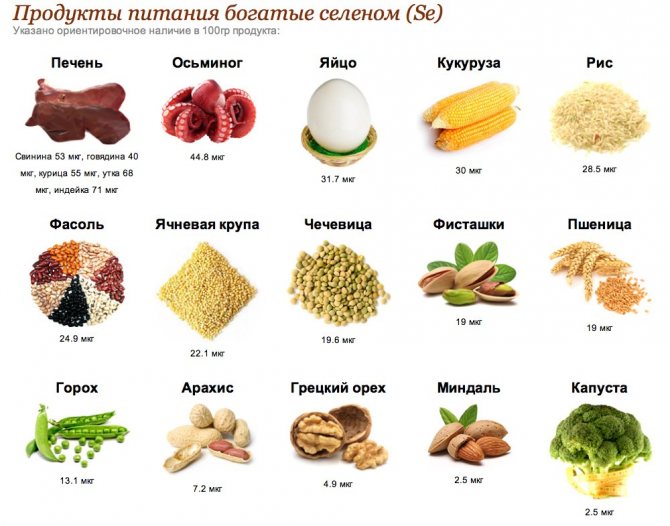
Please note: the champion in selenium content is Bertolecia, or Brazil nut - one of its fruits can cover the body's daily need for this element. A certain disadvantage may be the exotic nature and low prevalence of the product for ordinary Russians.
Our usual products containing selenium are:
- poultry meat (turkey, duck, chicken) 70-55 mcg and animal meat (pork, lamb, beef) - 55-40 mcg, and poultry meat contains more selenium;
- seafood (fish, shrimp, squid and more exotic lobsters, octopus, crabs) - 50-35 mcg;
- chicken eggs – 32 mcg;
- grains and legumes – corn, rice, beans, lentils – 30-20 mcg;
- pistachios – 19 mcg;
- peas – 13 mcg;
- common nuts – peanuts, walnuts, hazel, almonds – 7-2.5 mcg;
- vegetables and fruits – up to a maximum of 2 mcg.
As you can see, a varied diet, even without special correction, can meet the body's needs for selenium. Moreover, calculating the number of necessary products is very simple.
A state of selenium deficiency or excess can be established if disorders are suspected and confirmed by appropriate special biochemical tests. If the element is insufficient, correction is carried out with diet and, in the case of laboratory-proven ineffectiveness of the diet, drugs containing selenium may be prescribed.
Important! Self-medicating, taking selenium supplements without prescription, or exceeding the dosage (to get better quickly) is extremely dangerous and is strictly prohibited.
You will receive more detailed information about the function of selenium in the body, the consequences of its excess and deficiency by watching this video review:
General practitioner, Sovinskaya Elena Nikolaevna
17, total, today
( 187 votes, average: 4.64 out of 5)
Augmentin: instructions for use, dosage
Panadol syrup for children: instructions for use, dosage

